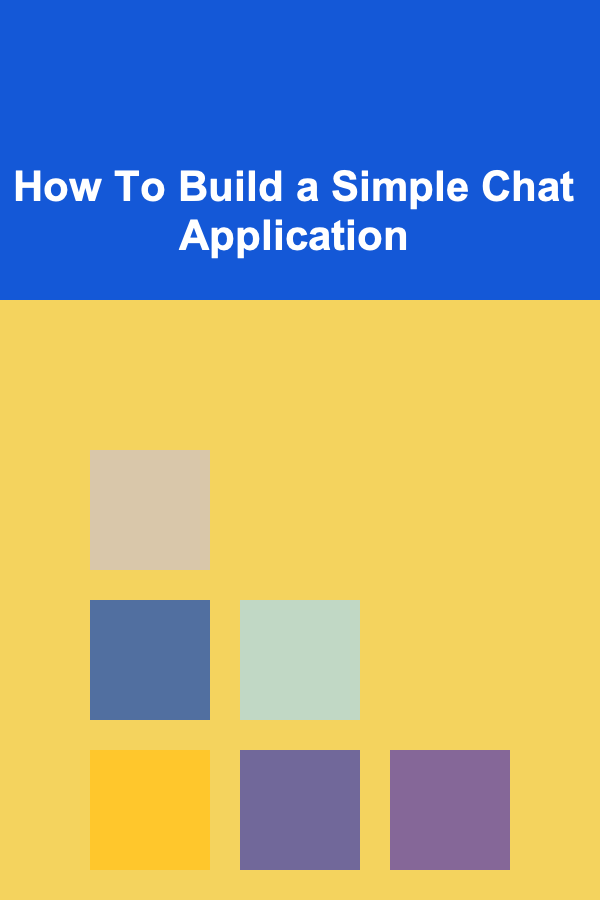
How To Build a Simple Chat Application
ebook include PDF & Audio bundle (Micro Guide)
$12.99$10.99
Limited Time Offer! Order within the next:

Building a simple chat application is a fantastic way to learn about real-time communication, networking, and the integration of various technologies. In this guide, we will walk through the steps necessary to build a basic chat app from scratch, focusing on the technologies that will allow for real-time messaging. By the end, you will have a functional chat application where users can send and receive messages in real-time.
In this article, we will focus on a web-based chat application. We'll use a stack that includes HTML, CSS, JavaScript, Node.js, and Socket.io. These technologies provide a solid foundation for building interactive, real-time applications with minimal complexity.
Key Technologies Used
- Node.js: A JavaScript runtime built on Chrome's V8 JavaScript engine, perfect for creating scalable server-side applications.
- Socket.io: A library that enables real-time, bidirectional communication between web clients and servers.
- HTML/CSS: The backbone for building the user interface (UI) of the application.
- JavaScript: For both the client-side and server-side logic that will drive the real-time communication between the users.
Before we dive into the actual coding, let's break down the process into manageable steps.
Step 1: Setting Up Your Project
The first step in building any application is setting up your development environment. For this chat app, we will need to install Node.js, which comes with npm (Node Package Manager) to manage our project dependencies.
-
Install Node.js : If you don't have Node.js installed, you can download and install it from the official website: https://nodejs.org/.
-
Create the Project Folder: Once you have Node.js installed, open your terminal and create a new folder for your project:
cd simple-chat-app -
Initialize the Project : Run the following command to initialize your project with npm, which will create a
package.jsonfile: -
Install Dependencies : The next step is to install the necessary libraries. For this chat application, we will need Express (a web framework for Node.js) and Socket.io (for real-time communication).
With these steps completed, you're now ready to start building your chat application!
Step 2: Setting Up the Server
Now that we've set up our project, let's create the backend that will handle the real-time messaging functionality.
1. Create the server.js file
In the root of your project folder, create a file named server.js. This file will contain the logic for starting the server and handling client connections.
const express = require('express');
const http = require('http');
const socketIo = require('socket.io');
// Create an Express app and HTTP server
const app = express();
const server = http.createServer(app);
// Set up Socket.io on the server
const io = socketIo(server);
// Serve static files (like HTML, CSS, JS) from the 'public' folder
app.use(express.static('public'));
// Set up a basic route for the homepage
app.get('/', (req, res) => {
res.sendFile(__dirname + '/public/index.html');
});
// Set up the Socket.io connection
io.on('connection', (socket) => {
console.log('a user connected');
// Broadcast messages to all users
socket.on('chat message', (msg) => {
io.emit('chat message', msg);
});
// Log when a user disconnects
socket.on('disconnect', () => {
console.log('user disconnected');
});
});
// Start the server on port 3000
server.listen(3000, () => {
console.log('listening on *:3000');
});
Explanation:
- express: A lightweight framework for building web servers in Node.js.
- http: A native Node.js module used to create the HTTP server.
- socket.io: This library enables real-time bidirectional event-based communication between the server and clients.
2. Understanding Socket.io Communication
io.on('connection'): This is where we handle incoming socket connections from clients. When a new client connects, we can log that and set up event listeners for things like receiving messages.socket.on('chat message'): This is where the server listens for chat messages from the client.io.emit('chat message'): This broadcasts the message to all connected clients.
The server is now set up to listen for connections and broadcast messages to all clients.
Step 3: Setting Up the Frontend
Now that we have a basic server running, let's build the user interface for the chat application. This will be an HTML page where users can type messages and see them in real time.
1. Create the index.html File
In the public folder (which you should create in your project directory), create an index.html file. This file will be the main page users interact with when they visit your app.
<html lang="en">
<head>
<meta charset="UTF-8">
<meta name="viewport" content="width=device-width, initial-scale=1.0">
<title>Simple Chat App</title>
<style>
body {
font-family: Arial, sans-serif;
background-color: #f5f5f5;
display: flex;
justify-content: center;
align-items: center;
height: 100vh;
margin: 0;
}
#chat-box {
background: white;
padding: 20px;
border-radius: 10px;
width: 300px;
height: 400px;
display: flex;
flex-direction: column;
justify-content: space-between;
}
#messages {
flex-grow: 1;
overflow-y: auto;
margin-bottom: 20px;
}
#input {
width: 100%;
padding: 10px;
border-radius: 5px;
border: 1px solid #ccc;
}
</style>
</head>
<body>
<div id="chat-box">
<div id="messages"></div>
<input id="input" type="text" placeholder="Type a message...">
</div>
<script src="/socket.io/socket.io.js"></script>
<script>
var socket = io();
// Send message when the user hits "Enter"
document.getElementById('input').addEventListener('keypress', function(e) {
if (e.key === 'Enter') {
var message = e.target.value;
socket.emit('chat message', message);
e.target.value = ''; // Clear the input field
}
});
// Listen for incoming messages
socket.on('chat message', function(msg) {
var messages = document.getElementById('messages');
var messageElement = document.createElement('div');
messageElement.textContent = msg;
messages.appendChild(messageElement);
messages.scrollTop = messages.scrollHeight; // Scroll to the bottom
});
</script>
</body>
</html>
Explanation:
- HTML Structure : The page consists of a
#chat-boxcontainer that holds the chat messages (#messages) and an input field (#input) for typing messages. - CSS Styles: Basic styling is used to center the chat box and give it a neat, clean look.
- JavaScript :
- We use the Socket.io client to connect to the server.
- The
keypressevent on the input field sends a message to the server when the Enter key is pressed. - The
chat messageevent is listened for, and when a message is received, it is appended to the message container (#messages).
Step 4: Running the Application
-
Start the Server: Open your terminal and run the following command to start the server:
-
Open the Chat App in Your Browser : Go to
http://localhost:3000in your web browser. You should see the chat interface where you can start typing and sending messages. -
Test Real-Time Messaging: Open the app in multiple browser windows or tabs. You should see messages appearing in real time across all instances when a message is sent.
Step 5: Enhancing the Chat Application
Now that you have the basic chat application working, there are several ways to enhance it. Here are some ideas for improvement:
- User Authentication: Add the ability to sign in with usernames so that each message is associated with a user.
- Private Messaging: Implement the ability to send messages to specific users, rather than broadcasting them to everyone.
- Chat Rooms: Allow users to join different chat rooms where they can talk about specific topics.
- Message History: Store messages in a database so that users can see past conversations when they reload the app.
Conclusion
In this tutorial, we built a simple chat application using Node.js and Socket.io. The project demonstrates how to set up a server using Node.js, use Socket.io to enable real-time communication, and build a basic front-end for a chat interface. While this app is basic, it lays the groundwork for much more advanced real-time web applications, and you can expand it with more features to suit your needs. By experimenting with the technologies and enhancing the app, you'll be able to build a highly functional and scalable chat application.

How to Choose the Right Storage Solutions for Your Tools
Read More
How to Make Money Online as a Social Media Manager: 10 Actionable Ideas
Read More
How to Utilize Security Signage to Deter Burglars
Read More
Printable Signs for Restaurants: Menus, Specials & More
Read More
How to Create Realistic Paper Flowers for Home Decor
Read More
How to Build a Life Goals Planner Around Your Values
Read MoreOther Products

How to Choose the Right Storage Solutions for Your Tools
Read More
How to Make Money Online as a Social Media Manager: 10 Actionable Ideas
Read More
How to Utilize Security Signage to Deter Burglars
Read More
Printable Signs for Restaurants: Menus, Specials & More
Read More
How to Create Realistic Paper Flowers for Home Decor
Read More